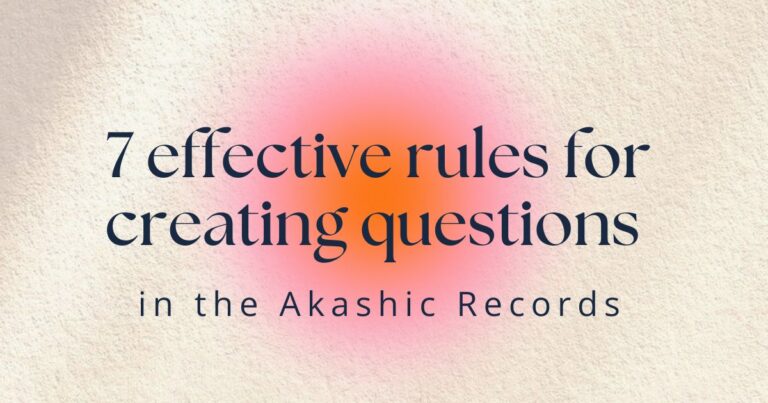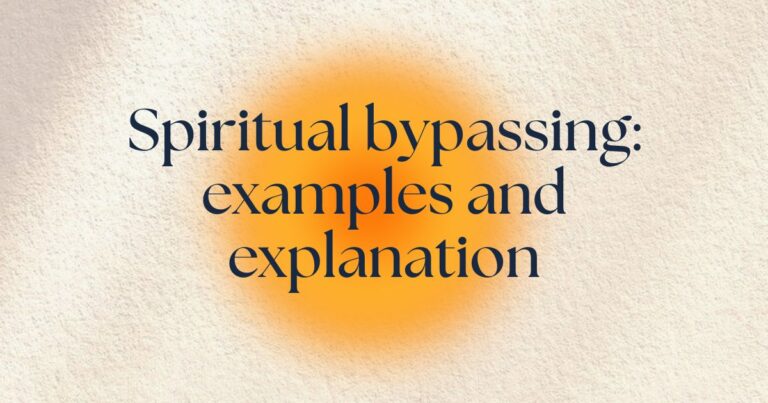Definition of spiritual bypassing – what it is and how to avoid it
Something unpleasant has happened in your life – a break-up, job loss, cheating. You feel anger, sadness, grief, shame. You’re on a spiritual path and you hear ‘be grateful’, ‘only love and goodness’, ‘get rid of those low-vibrational emotions’. And maybe you start to do just that: smiling, gritting your teeth, holding back tears. Maybe your voice gets tenser and tenser, or you sleep worse and worse, maybe you even feel less and less, but you doing your mantra every day ‘I am love’.
Yes of course you are love, only to feel love you still need to feel the other emotions that are inside you. And maybe anger, sadness, grief are just sitting there. From current events, or from those of your childhood. And if you are avoiding feeling what is alive in you… this is the phenomenon of ‘spiritual bypassing’, which can hinder your authentic transformation.
In this article I will shed light on the concept of spiritual bypassing, give examples from my life and share practical strategies for overcoming it. By understanding what spiritual bypassing is, you can approach your spiritual journey more holistically, promoting self-awareness and emotional healing.
Table of Contents
Definition of spiritual bypassing
Spiritual bypassing refers to the tendency to use spiritual beliefs and practices as a way to avoid confronting difficult emotions or unresolved challenges. Instead of directly facing and touching these issues, one may seek refuge in spiritual ideologies, believing that such practices can transcend or alleviate inner turmoil. Such avoidance often leads to a superficial sense of growth, masking deeper emotional wounds and hindering personal growth.
Example: you hear a colleague at work berating you. You feel angry, but instead you tell yourself that, after all, we are all love and you forgive her or him. You have suppressed your feelings. By the power of your mind you have shut down the emotion, in this case anger, which was there and wanted to be expressed. This emotion (like any emotion) carried a message that wanted to be communicated to you (maybe about overstepping boundaries, maybe a childhood wound resurfaced, or maybe it wanted to motivate you to express yourself).
Historical perspective
The term ‘spiritual bypassing’ was first introduced by psychologist and author John Welwood in the early 1980s. He used the term to describe a phenomenon he observed in which individuals used spiritual beliefs and practices to avoid dealing with unresolved psychological issues or emotional pain. Welwood explored this concept further in his book Toward a Psychology of Awakening, published in 1983, where he delved into the ways in which spiritual practice can sometimes be used as a defence mechanism to bypass deeper psychological work.
Examples of spiritual bypassing
There are as many examples of spiritual bypassing as there are people in the world. Each of us can find our own way of bypassing what is uncomfortable. We are, after all, creative creatures 🙂 I give some examples, but you will know best at what moments you suppress, bypass, avoid the issues. The moment you admit it to yourself, then you can begin the journey towards authenticity.
- Denying emotions: a person who experiences deep sadness or anger may dismiss these feelings as ‘negative’ or ‘unspiritual’, ‘low-vibrational’ choosing to suppress them rather than acknowledge and process them authentically. In his book Enlightenment of the Heart, Jack Kornfield interviews gurus, monks, nuns, people who have been on the path to enlightenment all their lives. He beautifully depicts how they are human and encounter ups and downs, low and high emotions now matter how enlightenment we are.
- An overemphasis on positivity: individuals may adopt an overly optimistic perspective, refusing to acknowledge the existence of pain or suffering in their lives and dismissing any challenges as mere illusions.
- Judgemental attitude: some individuals may develop a sense of spiritual superiority, looking down on others who are struggling and attributing their difficulties to a lack of spiritual enlightenment, or not trying hard enough.
- Escapism: rather than confronting reality (which may not be comfortable or pleasant), individuals may immerse themselves in spiritual practices or experiences to avoid uncomfortable truths or to anaesthetise themselves to emotional pain.
If you see any of these examples in yourself… remember that a large proportion of us do some kind of spiritual bypassing at some point in our lives. Sometimes emotions seem ‘too much’ or ‘intense’; you may not feel support from others; or there are other events happening. The fact that you have suppressed emotions may mean that at that moment you did not have the tools, the resources to fully express, to feel those emotions. With full love for yourself and your path, you can look at what has arisen in you in the past and feel what has been repressed, at your pace and with your full resources.

And what are resources?
They are internal and external tools that allow you to feel present in the moment. Resources restore a sense of security , inner peace and the ability to choose what you feel or do. With resources you have a greater ability to turn towards pain, uncomfortable emotions without feeling overwhelmed.
How spiritual bypassing affects mental and emotional wellbeing
Spiritual bypassing can have a detrimental effect on mental and emotional wellbeing. By bypassing authentic emotional experiences, individuals deny themselves the opportunity for true growth and healing. Repressed emotions can manifest in various forms such as anxiety, depression and even physical ailments, ultimately leading to a sense of disconnection from self and others.
Although we can suppress a particular emotion with the power of the mind, its blocked energy remains in the body. In the book When the Body Says No, author and physician Gabor Mate shares his many years of observations of people who have suppressed their emotions. In a very precise way, he is able to indicate how a particular emotion, for example in women who did not express anger towards their mothers as children, could translate into an increased risk of breast cancer. Gabor also mentions an important factor that plays a role in such cases – epigenetics.
I highly recommend you listen to Gabor’s podcast about, among other things, suppressing emotions with Tim Ferris ‘The Myth of normal, Metabolizing Anger, Processing Trauma, and Finding the Still Voice Within’
How you can avoid spiritual bypassing
1. Nurture self-awareness through mindfulness
In the evening give yourself a moment to reflect on the events of the day. Observe your thoughts, emotions and behaviours… do you see patterns of avoidance or denial? Was there a situation, a moment, where you felt an emotion but did not fully express it? If you are in a position to do so you can connect with that emotion in the moment, if not then the realisation of that emotion itself may be the first step.
2. Connect with vulnerability
Allow yourself to experience uncomfortable emotions without judgement, recognising that they are an integral part of the human experience. You can do this in the privacy of your home, in nature where no one can see. Sometimes just giving yourself the space of 15 or 30 minutes of simply allowing yourself to feel is enough. Sometimes it can be useful to use tools, for example you can write down on a piece of paper everything you feel. Without censoring, fully expressing what is inside you. Another option is to plant a cushion in front of you that represents the person and express to them what has not been said. You can also use pillow punching.
It is important that you don’t judge/judge yourself, just express yourself. What wants to flow out of you. You yourself will be surprised that the moment you let go of control what will flow out 🙂 And the feeling of relief when you finally say, shout, write what is inside you will be incredibly freeing.
3. Seek support
Engage in therapy, spiritual counselling or support groups to explore and resolve underlying emotional issues in a safe environment. There are currently many options- psychotherapists, therapists, spiritual methods. It’s worth being understanding to yourself in the process of finding a person or group that you feel safe with. And when you find it… you will definitely feel it 🙂 Here is the possibility to work with me: link.
4. Adopt a holistic approach
Integrate spiritual practices with psychological insights and therapeutic techniques, supporting a balanced and holistic approach to personal growth and healing. There is no one golden practice that will be the answer to everything. By combining your experiences and looking at them from a bird’s-eye perspective, you can gain an entirely new approach. Sometimes it takes time to integrate certain elements of your development.

The emotion code, the Hawkins method, and spiritual bypassing
You may have heard of the book “The Emotion Code” or the whole series of books by Dr. Hawkins, which touch on the subject of emotions. I wrote “touch on them” because you won’t find there a description of how to express emotions, in the way I described in the article. For me (completely subjectively) these books are a good start to be more aware of one’s emotions. Being frozen and cut off from emotions for a large part of my life, I was not able to do, for example, an exercise like the one I described above with expressing emotions.
By reading and doing the exercises from ‘The Emotion Code’ (where I sat with a pendulum and magnesium every day for a month and released one emotion at a time) I started to become aware of what emotions I might have and at what moments in my life they appeared. The next stage were the tantric workshops and expressing and feeling emotions on deeper levels. That was my path – it may be very different for you.
Gratitude as a reward
When you express your feelings as they are and not run away from them. Welcome them lovingly and accepting them it will open up a wonderful path of gratitude. Gratitude to yourself You will regain a sense of power and agency (this does not mean being unkind, shouting at others, etc.). You will approach yourself and, consequently, others with greater sensitivity.
Summary
In your spiritual journey, it is important to approach all manifestations of yourself with courage and sensitivity. By recognising the moments when you use spiritual bypassing in your life, you can take a deeper journey towards authenticity. I wish you much success on this journey!
The book links I provide are affiliate links.
Frequently Asked Questions (FAQ)
1. What is spiritual bypassing?
Spiritual bypassing refers to the tendency to use spiritual beliefs and practices as a way to avoid confronting difficult emotions or unresolved challenges.
2. How can I avoid spiritual bypassing?
Among other things, by cultivating self-awareness; accepting all emotions that arise within you; using therapeutic, spiritual support.
3. Does spiritual bypassing affect physical health?
Yes. The suppression of emotions can have negative effects on mental and physical health.
4. Can spiritual bypassing block spiritual development?
Yes, by avoiding your emotions, you may be hindering your ability to connect with your authenticity.





